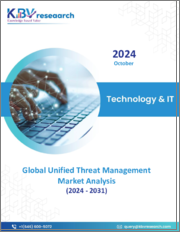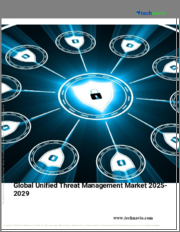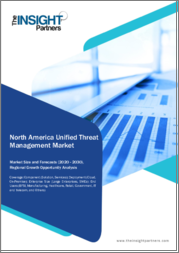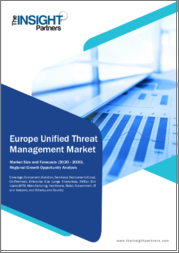
|
시장보고서
상품코드
1584909
세계의 통합 위협 관리 시장 : 시장 규모, 점유율, 동향 분석 보고서 - 전개별, 기업 규모별, 최종 용도별, 구성요소별, 지역별 전망 및 예측(2024-2031년)Global Unified Threat Management Market Size, Share & Trends Analysis Report By Deployment (Cloud, and On-premise), By Enterprise Size, By End Use, By Component, By Regional Outlook and Forecast, 2024 - 2031 |
||||||
세계 통합 위협 관리 시장 규모는 예측 기간 동안 14.9%의 CAGR로 성장하여 2031년까지 165억 달러에 달할 것으로 예상됩니다.
KBV Cardinal Matrix에 제시된 분석에 따르면 Huawei Technologies Co., Ltd., Cisco Systems, Inc. 및 IBM Corporation이 통합 위협 관리 시장의 선구자이며, Fortinet, Inc. Networks, Inc., Barracuda Networks, Inc. 등이 통합 위협 관리 시장의 주요 혁신 기업이며, 2024년 10월 Juniper Networks, Inc. 보안 보증을 갖춘 AI 중심 프레임워크에 보안 서비스를 발표할 예정입니다. 이 서비스는 Mist AI와 Marvis 가상 비서(Marvis Virtual Assistant)를 활용하여 이상 징후를 감지하고 문제를 효율적으로 해결함으로써 네트워크의 건전성과 보안에 대한 통합된 시각을 제공하는 것을 목표로 합니다.
시장 성장요인
통합 위협 관리(UTM) 장치는 방화벽, 침입 탐지 및 방지 시스템(IDPS), 안티바이러스 보호와 같은 다양한 보안 기능을 결합한 통합 접근 방식으로 권장되는 솔루션으로 등장했습니다. 방화벽은 방어의 최전선에서 네트워크 트래픽을 제어하고 무단 액세스를 방지하는 역할을 합니다. 동시에 IDPS 기능을 통해 의심스러운 활동을 실시간으로 탐지할 수 있습니다. 이는 APT와 같은 지속적이고 은밀한 위협에 대응하는 데 필수적입니다.
또한, 직원들이 다양한 장소와 기기에서 회사 네트워크에 접속하는 경우가 많아지면서 보안 관리의 복잡성이 크게 증가했습니다. 사무실 중심 네트워크용으로 설계된 기존의 보안 대책은 이러한 분산된 환경을 관리하기에 충분하지 않은 것으로 판명되는 경우가 많아졌습니다. 따라서 원격 근무자와 조직의 핵심 시스템 간의 데이터 흐름을 보호할 수 있는 보다 고도화되고 중앙 집중화된 보안 관리 솔루션의 도입이 필요하게 되었습니다. 이처럼 원격 근무와 클라우드 서비스로의 전환으로 인해 UTM 도구에 대한 수요가 증가하고 있습니다.
시장 억제요인
지속적인 업데이트와 모니터링의 필요성은 새로운 위협이 주기적으로 출현하는 사이버 보안 환경의 역동적인 특성을 강조합니다. 조직은 이러한 위협에 효과적으로 대응하기 위해 UTM 시스템을 지속적으로 업데이트해야 합니다. 이러한 지속적인 경계의 필요성은 비용 증가로 이어져 조직의 IT 부서에 많은 시간과 노력을 요구합니다. 따라서 높은 초기 투자 비용과 지속적인 유지보수 비용의 조합은 UTM 솔루션을 고려하는 조직에 큰 장벽이 될 수 있습니다.
구성요소 전망
구성요소에 따라 시장은 하드웨어, 소프트웨어, 가상으로 나뉩니다. 하드웨어 부문은 2023년 시장에서 46%의 매출 점유율을 차지할 것으로 예상됩니다. 이러한 성장은 신뢰할 수 있고 강력한 성능을 제공하는 물리적 보안 장치에 대한 선호도가 높아지면서 온프레미스 인프라를 보호하고자 하는 조직에 적합하다는 점이 성장의 원동력입니다.
기업 규모 전망
기업 규모에 따라 시장은 중소기업과 대기업으로 분류됩니다. 대기업 부문은 2023년 시장에서 45%의 매출 점유율을 차지할 것으로 예상됩니다. 대규모 조직은 종종 여러 위치 또는 원격 지점에서 분산된 운영을 하는 경우가 많기 때문에 사이버 위협에 더 취약합니다.
최종 용도 전망
최종 용도별로 시장은 BFSI, 정부, 헬스케어, 소매, 제조, 통신 및 IT, 기타로 분류됩니다. 헬스케어 부문은 2023년 14%의 매출 점유율을 기록했습니다. 헬스케어 서비스의 중요성과 의료 데이터의 기밀성은 헬스케어 조직에 독특한 도전을 제시하며 데이터 도난과 랜섬웨어에 취약하게 만듭니다.
전개 전망
전개에 따라 시장은 클라우드와 온프레미스로 나뉩니다. 온프레미스 부문은 2023년 시장에서 38%의 매출 점유율을 차지할 것으로 예상됩니다. 온프레미스 UTM 솔루션은 기업에 네트워크 보안을 관리할 수 있는 물리적 내부 접근 방식을 제공합니다. 이는 의료, 정부, 은행 및 금융 서비스 산업과 같이 민감한 데이터를 관리하는 분야에 특히 중요합니다.
지역 전망
지역별로 시장은 북미, 유럽, 아시아태평양, 라틴아메리카, 중동 및 아프리카로 분석되었습니다. 유럽 부문은 2023년 시장에서 30%의 매출 점유율을 기록할 것으로 예상됩니다. 유럽의 금융, 제조 및 소매 조직은 이러한 규정을 준수하고 증가하는 사이버 위협으로부터 보호하기 위해 UTM 솔루션에 점점 더 많은 관심을 기울이고 있습니다.
시장 경쟁 및 특성
통합 위협 관리(UTM) 시장은 종합적인 사이버 보안 솔루션에 대한 수요가 증가함에 따라 경쟁이 치열해지고 있습니다. 주요 시장 특성으로는 방화벽, 침입탐지, 안티바이러스, VPN 기능 등 올인원 보안 기능이 있으며, UTM은 간소화된 보안 관리를 원하는 중소기업에게 인기 있는 선택이 되고 있습니다. 위협 탐지, AI 통합, 확장성의 혁신은 중요한 차별화 요소입니다. 벤더들은 진화하는 사이버 보안 위협에 효율적으로 대응하기 위해 도입 용이성, 성능, 비용 효율성을 놓고 경쟁하고 있습니다.
목차
제1장 시장 범위와 조사 방법
- 시장 정의
- 목적
- 시장 범위
- 세분화
- 조사 방법
제2장 시장 요람
- 주요 하이라이트
제3장 시장 개요
- 소개
- 개요
- 시장 구성과 시나리오
- 개요
- 시장에 영향을 미치는 주요 요인
- 시장 성장 촉진요인
- 시장 성장 억제요인
- 시장 기회
- 시장 과제
제4장 경쟁 분석 - 세계
- KBV Cardinal Matrix
- 최근 업계 전체의 전략적 전개
- 파트너십, 협업 및 계약
- 제품 발매와 제품 확대
- 인수와 합병
- 시장 점유율 분석 2023
- 주요 성공 전략
- 주요 전략
- 주요 전략적 활동
- Porter's Five Forces 분석
제5장 세계의 통합 위협 관리 시장 : 전개별
- 세계의 클라우드 시장 : 지역별
- 세계의 온프레미스 시장 : 지역별
제6장 세계의 통합 위협 관리 시장 : 기업 규모별
- 세계의 중소기업 시장 : 지역별
- 세계의 대기업 시장 : 지역별
제7장 세계의 통합 위협 관리 시장 : 최종 용도별
- 세계의 BFSI 시장 : 지역별
- 세계의 정부 시장 : 지역별
- 세계의 헬스케어 시장 : 지역별
- 세계의 제조 시장 : 지역별
- 세계의 소매 시장 : 지역별
- 세계의 통신·IT 시장 : 지역별
- 세계의 기타 최종 용도 시장 : 지역별
제8장 세계의 통합 위협 관리 시장 : 구성요소별
- 세계의 하드웨어 시장 : 지역별
- 세계의 소프트웨어 시장 : 지역별
- 세계의 가상 시장 : 지역별
제9장 세계의 통합 위협 관리 시장 : 지역별
- 북미
- 북미 : 국가별
- 미국
- 캐나다
- 멕시코
- 기타 북미
- 북미 : 국가별
- 유럽
- 유럽 : 국가별
- 독일
- 영국
- 프랑스
- 러시아
- 스페인
- 이탈리아
- 기타 유럽
- 유럽 : 국가별
- 아시아태평양
- 아시아태평양 : 국가별
- 중국
- 일본
- 인도
- 한국
- 싱가포르
- 말레이시아
- 기타 아시아태평양
- 아시아태평양 : 국가별
- 라틴아메리카, 중동 및 아프리카
- 라틴아메리카, 중동 및 아프리카 : 국가별
- 브라질
- 아르헨티나
- 아랍에미리트
- 사우디아라비아
- 남아프리카공화국
- 나이지리아
- 기타 라틴아메리카, 중동 및 아프리카
- 라틴아메리카, 중동 및 아프리카 : 국가별
제10장 기업 개요
- Check Point Software Technologies Ltd
- IBM Corporation
- Fortinet, Inc
- Sophos Group PLC(Thoma Bravo)
- Barracuda Networks, Inc(KKR & Co. Inc.)
- Trend Micro, Inc
- Cisco Systems, Inc
- Huawei Technologies Co, Ltd.(Huawei Investment & Holding Co., Ltd.)
- Juniper Networks, Inc
- SonicWall, Inc
제11장 통합 위협 관리 시장 성공 필수 조건
ksm 24.11.15The Global Unified Threat Management Market size is expected to reach $16.5 billion by 2031, rising at a market growth of 14.9% CAGR during the forecast period.
UTM solutions provide a comprehensive security approach, integrating firewalls, intrusion prevention, and data encryption to safeguard banking networks against various threats. Additionally, regulatory compliance requirements, such as PCI DSS, push financial institutions to adopt advanced security systems like UTM to ensure data protection, contributing to the segment's strong demand for UTM solutions. Thus, he BFSI segment recorded 26% revenue share in the unified threat management market in 2023. The BFSI industry is a prime target for cyber-attacks, including phishing, malware, and ransomware, due to the high value of the data it handles.
The major strategies followed by the market participants are Product Launehes as the key developmental strategy to keep pace with the changing demands of end users. For instance, In October, 2024, Juniper Networks, Inc. unveiling its security services into an AI-centric framework with its new Secure AI-Native Edge and cloud-based Security Assurance. These offerings aim to provide a unified view of network health and security, leveraging Mist AI and Marvis virtual assistant to detect anomalies and resolve issues efficiently. Additionally, In June, 2024, Trend Micro Incorporated has announced the launch of its first consumer security solutions designed to combat emerging threats in the age of AI PCs, set to be available in late 2024. Collaborating with Intel, Trend Micro will leverage next-generation processors to enhance local email defense features, improving user privacy and security. The new capabilities will also address risks associated with AI applications, showcasing Trend's commitment to securing both enterprises and individual consumers in a rapidly evolving digital landscape.
Based on the Analysis presented in the KBV Cardinal matrix; Huawei Technologies Co., Ltd., Cisco Systems, Inc. and IBM Corporation are the forerunners in the Unified Threat Management Market. Companies such as Fortinet, Inc., Juniper Networks, Inc., and Barracuda Networks, Inc. are some of the key innovators in Unified Threat Management Market. In October, 2024, Juniper Networks, Inc. unveiling its security services into an AI-centric framework with its new Secure AI-Native Edge and cloud-based Security Assurance. These offerings aim to provide a unified view of network health and security, leveraging Mist AI and Marvis virtual assistant to detect anomalies and resolve issues efficiently.
Market Growth Factors
Unified Threat Management (UTM) devices have emerged as a preferred solution due to their integrated approach, combining various security functions like firewalls, intrusion detection and prevention systems (IDPS), and antivirus protection. Firewalls are the first line of defense, controlling network traffic and preventing unauthorized access. At the same time, IDPS capabilities enable real-time detection of suspicious activities, which is crucial for countering persistent and stealthy threats like APTs.
Additionally, with employees accessing company networks from various locations and devices, the complexity of managing security has increased significantly. Traditional security measures designed for office-centric networks often proved inadequate for managing these dispersed environments. This has necessitated the adoption of more advanced and centralized security management solutions capable of protecting data flows between remote workers and the organization's core systems. Thus, the shift towards remote work and cloud services has propelled the demand for UTM tools.
Market Restraining Factors
The need for continuous updates and monitoring also highlights the dynamic nature of the cybersecurity landscape, where new threats emerge regularly. Organizations must always update their UTM systems to respond effectively to these threats. This ongoing need for vigilance contributes to higher costs and demands time and effort from the organization's IT department. Thus, combining high initial investment and continuous maintenance expenses can be a significant barrier for organizations considering UTM solutions.
The leading players in the market are competing with diverse innovative offerings to remain competitive in the market. The above illustration shows the percentage of revenue shared by some of the leading companies in the market. The leading players of the market are adopting various strategies in order to cater demand coming from the different industries. The key developmental strategies in the market are Product Launches and Product Expansions.
Component Outlook
Based on component, the market is divided into hardware, software, and virtual. The hardware segment acquired 46% revenue share in the market in 2023. This growth is driven by the preference for physical security devices that offer reliable and robust performance, making them ideal for organizations seeking to secure on-premises infrastructure.
Enterprise Size Outlook
On the basis of enterprise size, the market is classified into small & medium sized enterprises (SMEs) and large enterprises. The large enterprises segment procured 45% revenue share in the market in 2023. Large organizations often have distributed operations with multiple locations and remote branches, making them more vulnerable to cyber threats.
End Use Outlook
By end use, the market is divided into BFSI, government, healthcare, retail, manufacturing, telecom & IT, and others. The healthcare segment witnessed 14% revenue share in the in 2023. The critical nature of healthcare services and the sensitivity of medical data present distinctive challenges for healthcare organizations, rendering them susceptible to data theft and ransomware.
Deployment Outlook
Based on deployment, the market is bifurcated into cloud and on-premise. The on-premise segment garnered 38% revenue share in the market in 2023. On-premise UTM solutions provide businesses with a physical, in-house approach to managing network security. This is especially critical for sectors that manage sensitive data, including healthcare, government, and the banking and financial services industry.
Regional Outlook
Region-wise, the market is analyzed across North America, Europe, Asia Pacific, and LAMEA. The Europe segment recorded 30% revenue share in the market in 2023. European finance, manufacturing, and retail organizations have increasingly turned to UTM solutions to ensure compliance with these regulations and protect against growing cyber threats.
Market Competition and Attributes
The Unified Threat Management (UTM) market is highly competitive, driven by the growing need for comprehensive cybersecurity solutions. Key market attributes include all-in-one security features like firewall, intrusion detection, antivirus, and VPN capabilities, making UTM a popular choice for small to medium-sized businesses seeking simplified security management. Innovation in threat detection, AI integration, and scalability are critical differentiators. Vendors compete on ease of deployment, performance, and cost-effectiveness, aiming to address evolving cybersecurity threats efficiently.
Recent Strategies Deployed in the Market
- Oct-2024: Juniper Networks, Inc. unveiling its security services into an AI-centric framework with its new Secure AI-Native Edge and cloud-based Security Assurance. These offerings aim to provide a unified view of network health and security, leveraging Mist AI and Marvis virtual assistant to detect anomalies and resolve issues efficiently.
- Sep-2024: Huawei Technologies formed a partnership with Huanghe Lab, a prominent network security research institute in China, to launch a security foundation model aimed at enhancing enterprise security frameworks globally. This model, developed using Huawei's expertise in network security and their PanguLM technology, focuses on intelligent security operations and advanced threat detection, improving operational efficiency tenfold. The partnership aims to bolster network security product evaluation and support enterprises in identifying and addressing potential vulnerabilities effectively.
- Aug-2024: Fortinet has completed the acquisition of Lacework, a trailblazer in cloud security and cloud-native application protection platforms, to enhance its cybersecurity offerings. This integration aligns with Fortinet's strategy to provide consistent security across on-premises and cloud environments. The combination of Lacework's advanced cloud-native platform with Fortinet's Security Fabric aims to deliver a comprehensive, AI-driven cloud security solution, further solidifying Fortinet's leadership in the market with an expanded patent portfolio.
- Aug-2024: Cisco entered into an agreement to acquire Robust Intelligence, a security startup specializing in protecting AI models throughout their development-to-production lifecycle. This integration aims to enhance Cisco Security Cloud by streamlining threat protection for AI applications and improving visibility into AI traffic. This acquisition will enable the seamless delivery of advanced AI security processing within Cisco's existing security and networking products, strengthening overall threat management capabilities.
- Aug-2024: Check Point Software Technologies, a leader in cybersecurity solutions, has acquired Cyberint Technologies, a provider of External Risk Management solutions. This acquisition aims to strengthen Check Point's Security Operations Center and expand its managed threat intelligence services by integrating Cyberint's AI-driven technologies into the Check Point Infinity Platform.
- Aug-2024: Fortinet took over Next DLP, a leader in insider risk and data protection, to enhance its Unified SASE (Secure Access Service Edge) solution. This strategic acquisition will integrate Next DLP's cloud-native SaaS data protection platform and advanced AI/ML capabilities into Fortinet's offerings. This move aims to strengthen Fortinet's position in standalone and integrated data loss prevention markets, enabling customers to effectively manage insider risks across SASE and endpoint environments.
List of Key Companies Profiled
- Check Point Software Technologies Ltd.
- IBM Corporation
- Fortinet, Inc.
- Sophos Group PLC (Thoma Bravo)
- Barracuda Networks, Inc. (KKR & Co. Inc.)
- Trend Micro, Inc.
- Cisco Systems, Inc.
- Huawei Technologies Co., Ltd. (Huawei Investment & Holding Co., Ltd.)
- Juniper Networks, Inc.
- Sonicwall, Inc.
Global Unified Threat Management Market Report Segmentation
By Deployment
- Cloud
- On-premise
By Enterprise Size
- SMEs
- Large Enterprise
By End Use
- BFSI
- Government
- Healthcare
- Manufacturing
- Retail
- Telecom & IT
- Other End Use
By Component
- Hardware
- Software
- Virtual
By Geography
- North America
- US
- Canada
- Mexico
- Rest of North America
- Europe
- Germany
- UK
- France
- Russia
- Spain
- Italy
- Rest of Europe
- Asia Pacific
- China
- Japan
- India
- South Korea
- Singapore
- Malaysia
- Rest of Asia Pacific
- LAMEA
- Brazil
- Argentina
- UAE
- Saudi Arabia
- South Africa
- Nigeria
- Rest of LAMEA
Table of Contents
Chapter 1. Market Scope & Methodology
- 1.1 Market Definition
- 1.2 Objectives
- 1.3 Market Scope
- 1.4 Segmentation
- 1.4.1 Global Unified Threat Management Market, by Deployment
- 1.4.2 Global Unified Threat Management Market, by Enterprise Size
- 1.4.3 Global Unified Threat Management Market, by End Use
- 1.4.4 Global Unified Threat Management Market, by Component
- 1.4.5 Global Unified Threat Management Market, by Geography
- 1.5 Methodology for the research
Chapter 2. Market at a Glance
- 2.1 Key Highlights
Chapter 3. Market Overview
- 3.1 Introduction
- 3.1.1 Overview
- 3.1.1.1 Market Composition and Scenario
- 3.1.1 Overview
- 3.2 Key Factors Impacting the Market
- 3.2.1 Market Drivers
- 3.2.2 Market Restraints
- 3.2.3 Market Opportunities
- 3.2.4 Market Challenges
Chapter 4. Competition Analysis - Global
- 4.1 KBV Cardinal Matrix
- 4.2 Recent Industry Wide Strategic Developments
- 4.2.1 Partnerships, Collaborations and Agreements
- 4.2.2 Product Launches and Product Expansions
- 4.2.3 Acquisition and Mergers
- 4.3 Market Share Analysis, 2023
- 4.4 Top Winning Strategies
- 4.4.1 Key Leading Strategies: Percentage Distribution (2020-2024)
- 4.4.2 Key Strategic Move: (Product Launches and Product Expansions: 2020, Apr - 2024, Oct) Leading Players
- 4.5 Porter Five Forces Analysis
Chapter 5. Global Unified Threat Management Market by Deployment
- 5.1 Global Cloud Market by Region
- 5.2 Global On-premise Market by Region
Chapter 6. Global Unified Threat Management Market by Enterprise Size
- 6.1 Global SMEs Market by Region
- 6.2 Global Large Enterprise Market by Region
Chapter 7. Global Unified Threat Management Market by End Use
- 7.1 Global BFSI Market by Region
- 7.2 Global Government Market by Region
- 7.3 Global Healthcare Market by Region
- 7.4 Global Manufacturing Market by Region
- 7.5 Global Retail Market by Region
- 7.6 Global Telecom & IT Market by Region
- 7.7 Global Other End Use Market by Region
Chapter 8. Global Unified Threat Management Market by Component
- 8.1 Global Hardware Market by Region
- 8.2 Global Software Market by Region
- 8.3 Global Virtual Market by Region
Chapter 9. Global Unified Threat Management Market by Region
- 9.1 North America Unified Threat Management Market
- 9.1.1 North America Unified Threat Management Market by Deployment
- 9.1.1.1 North America Cloud Market by Region
- 9.1.1.2 North America On-premise Market by Region
- 9.1.2 North America Unified Threat Management Market by Enterprise Size
- 9.1.2.1 North America SMEs Market by Country
- 9.1.2.2 North America Large Enterprise Market by Country
- 9.1.3 North America Unified Threat Management Market by End Use
- 9.1.3.1 North America BFSI Market by Country
- 9.1.3.2 North America Government Market by Country
- 9.1.3.3 North America Healthcare Market by Country
- 9.1.3.4 North America Manufacturing Market by Country
- 9.1.3.5 North America Retail Market by Country
- 9.1.3.6 North America Telecom & IT Market by Country
- 9.1.3.7 North America Other End Use Market by Country
- 9.1.4 North America Unified Threat Management Market by Component
- 9.1.4.1 North America Hardware Market by Country
- 9.1.4.2 North America Software Market by Country
- 9.1.4.3 North America Virtual Market by Country
- 9.1.5 North America Unified Threat Management Market by Country
- 9.1.5.1 US Unified Threat Management Market
- 9.1.5.1.1 US Unified Threat Management Market by Deployment
- 9.1.5.1.2 US Unified Threat Management Market by Enterprise Size
- 9.1.5.1.3 US Unified Threat Management Market by End Use
- 9.1.5.1.4 US Unified Threat Management Market by Component
- 9.1.5.2 Canada Unified Threat Management Market
- 9.1.5.2.1 Canada Unified Threat Management Market by Deployment
- 9.1.5.2.2 Canada Unified Threat Management Market by Enterprise Size
- 9.1.5.2.3 Canada Unified Threat Management Market by End Use
- 9.1.5.2.4 Canada Unified Threat Management Market by Component
- 9.1.5.3 Mexico Unified Threat Management Market
- 9.1.5.3.1 Mexico Unified Threat Management Market by Deployment
- 9.1.5.3.2 Mexico Unified Threat Management Market by Enterprise Size
- 9.1.5.3.3 Mexico Unified Threat Management Market by End Use
- 9.1.5.3.4 Mexico Unified Threat Management Market by Component
- 9.1.5.4 Rest of North America Unified Threat Management Market
- 9.1.5.4.1 Rest of North America Unified Threat Management Market by Deployment
- 9.1.5.4.2 Rest of North America Unified Threat Management Market by Enterprise Size
- 9.1.5.4.3 Rest of North America Unified Threat Management Market by End Use
- 9.1.5.4.4 Rest of North America Unified Threat Management Market by Component
- 9.1.5.1 US Unified Threat Management Market
- 9.1.1 North America Unified Threat Management Market by Deployment
- 9.2 Europe Unified Threat Management Market
- 9.2.1 Europe Unified Threat Management Market by Deployment
- 9.2.1.1 Europe Cloud Market by Country
- 9.2.1.2 Europe On-premise Market by Country
- 9.2.2 Europe Unified Threat Management Market by Enterprise Size
- 9.2.2.1 Europe SMEs Market by Country
- 9.2.2.2 Europe Large Enterprise Market by Country
- 9.2.3 Europe Unified Threat Management Market by End Use
- 9.2.3.1 Europe BFSI Market by Country
- 9.2.3.2 Europe Government Market by Country
- 9.2.3.3 Europe Healthcare Market by Country
- 9.2.3.4 Europe Manufacturing Market by Country
- 9.2.3.5 Europe Retail Market by Country
- 9.2.3.6 Europe Telecom & IT Market by Country
- 9.2.3.7 Europe Virtual Market by Country
- 9.2.4 Europe Unified Threat Management Market by Component
- 9.2.4.1 Europe Hardware Market by Country
- 9.2.4.2 Europe Software Market by Country
- 9.2.4.3 Europe Other End Use Market by Country
- 9.2.5 Europe Unified Threat Management Market by Country
- 9.2.5.1 Germany Unified Threat Management Market
- 9.2.5.1.1 Germany Unified Threat Management Market by Deployment
- 9.2.5.1.2 Germany Unified Threat Management Market by Enterprise Size
- 9.2.5.1.3 Germany Unified Threat Management Market by End Use
- 9.2.5.1.4 Germany Unified Threat Management Market by Component
- 9.2.5.2 UK Unified Threat Management Market
- 9.2.5.2.1 UK Unified Threat Management Market by Deployment
- 9.2.5.2.2 UK Unified Threat Management Market by Enterprise Size
- 9.2.5.2.3 UK Unified Threat Management Market by End Use
- 9.2.5.2.4 UK Unified Threat Management Market by Component
- 9.2.5.3 France Unified Threat Management Market
- 9.2.5.3.1 France Unified Threat Management Market by Deployment
- 9.2.5.3.2 France Unified Threat Management Market by Enterprise Size
- 9.2.5.3.3 France Unified Threat Management Market by End Use
- 9.2.5.3.4 France Unified Threat Management Market by Component
- 9.2.5.4 Russia Unified Threat Management Market
- 9.2.5.4.1 Russia Unified Threat Management Market by Deployment
- 9.2.5.4.2 Russia Unified Threat Management Market by Enterprise Size
- 9.2.5.4.3 Russia Unified Threat Management Market by End Use
- 9.2.5.4.4 Russia Unified Threat Management Market by Component
- 9.2.5.5 Spain Unified Threat Management Market
- 9.2.5.5.1 Spain Unified Threat Management Market by Deployment
- 9.2.5.5.2 Spain Unified Threat Management Market by Enterprise Size
- 9.2.5.5.3 Spain Unified Threat Management Market by End Use
- 9.2.5.5.4 Spain Unified Threat Management Market by Component
- 9.2.5.6 Italy Unified Threat Management Market
- 9.2.5.6.1 Italy Unified Threat Management Market by Deployment
- 9.2.5.6.2 Italy Unified Threat Management Market by Enterprise Size
- 9.2.5.6.3 Italy Unified Threat Management Market by End Use
- 9.2.5.6.4 Italy Unified Threat Management Market by Component
- 9.2.5.7 Rest of Europe Unified Threat Management Market
- 9.2.5.7.1 Rest of Europe Unified Threat Management Market by Deployment
- 9.2.5.7.2 Rest of Europe Unified Threat Management Market by Enterprise Size
- 9.2.5.7.3 Rest of Europe Unified Threat Management Market by End Use
- 9.2.5.7.4 Rest of Europe Unified Threat Management Market by Component
- 9.2.5.1 Germany Unified Threat Management Market
- 9.2.1 Europe Unified Threat Management Market by Deployment
- 9.3 Asia Pacific Unified Threat Management Market
- 9.3.1 Asia Pacific Unified Threat Management Market by Deployment
- 9.3.1.1 Asia Pacific Cloud Market by Country
- 9.3.1.2 Asia Pacific On-premise Market by Country
- 9.3.2 Asia Pacific Unified Threat Management Market by Enterprise Size
- 9.3.2.1 Asia Pacific SMEs Market by Country
- 9.3.2.2 Asia Pacific Large Enterprise Market by Country
- 9.3.3 Asia Pacific Unified Threat Management Market by End Use
- 9.3.3.1 Asia Pacific BFSI Market by Country
- 9.3.3.2 Asia Pacific Government Market by Country
- 9.3.3.3 Asia Pacific Healthcare Market by Country
- 9.3.3.4 Asia Pacific Manufacturing Market by Country
- 9.3.3.5 Asia Pacific Retail Market by Country
- 9.3.3.6 Asia Pacific Telecom & IT Market by Country
- 9.3.3.7 Asia Pacific Other End Use Market by Country
- 9.3.4 Asia Pacific Unified Threat Management Market by Component
- 9.3.4.1 Asia Pacific Hardware Market by Country
- 9.3.4.2 Asia Pacific Software Market by Country
- 9.3.4.3 Asia Pacific Virtual Market by Country
- 9.3.5 Asia Pacific Unified Threat Management Market by Country
- 9.3.5.1 China Unified Threat Management Market
- 9.3.5.1.1 China Unified Threat Management Market by Deployment
- 9.3.5.1.2 China Unified Threat Management Market by Enterprise Size
- 9.3.5.1.3 China Unified Threat Management Market by End Use
- 9.3.5.1.4 China Unified Threat Management Market by Component
- 9.3.5.2 Japan Unified Threat Management Market
- 9.3.5.2.1 Japan Unified Threat Management Market by Deployment
- 9.3.5.2.2 Japan Unified Threat Management Market by Enterprise Size
- 9.3.5.2.3 Japan Unified Threat Management Market by End Use
- 9.3.5.2.4 Japan Unified Threat Management Market by Component
- 9.3.5.3 India Unified Threat Management Market
- 9.3.5.3.1 India Unified Threat Management Market by Deployment
- 9.3.5.3.2 India Unified Threat Management Market by Enterprise Size
- 9.3.5.3.3 India Unified Threat Management Market by End Use
- 9.3.5.3.4 India Unified Threat Management Market by Component
- 9.3.5.4 South Korea Unified Threat Management Market
- 9.3.5.4.1 South Korea Unified Threat Management Market by Deployment
- 9.3.5.4.2 South Korea Unified Threat Management Market by Enterprise Size
- 9.3.5.4.3 South Korea Unified Threat Management Market by End Use
- 9.3.5.4.4 South Korea Unified Threat Management Market by Component
- 9.3.5.5 Singapore Unified Threat Management Market
- 9.3.5.5.1 Singapore Unified Threat Management Market by Deployment
- 9.3.5.5.2 Singapore Unified Threat Management Market by Enterprise Size
- 9.3.5.5.3 Singapore Unified Threat Management Market by End Use
- 9.3.5.5.4 Singapore Unified Threat Management Market by Component
- 9.3.5.6 Malaysia Unified Threat Management Market
- 9.3.5.6.1 Malaysia Unified Threat Management Market by Deployment
- 9.3.5.6.2 Malaysia Unified Threat Management Market by Enterprise Size
- 9.3.5.6.3 Malaysia Unified Threat Management Market by End Use
- 9.3.5.6.4 Malaysia Unified Threat Management Market by Component
- 9.3.5.7 Rest of Asia Pacific Unified Threat Management Market
- 9.3.5.7.1 Rest of Asia Pacific Unified Threat Management Market by Deployment
- 9.3.5.7.2 Rest of Asia Pacific Unified Threat Management Market by Enterprise Size
- 9.3.5.7.3 Rest of Asia Pacific Unified Threat Management Market by End Use
- 9.3.5.7.4 Rest of Asia Pacific Unified Threat Management Market by Component
- 9.3.5.1 China Unified Threat Management Market
- 9.3.1 Asia Pacific Unified Threat Management Market by Deployment
- 9.4 LAMEA Unified Threat Management Market
- 9.4.1 LAMEA Unified Threat Management Market by Deployment
- 9.4.1.1 LAMEA Cloud Market by Country
- 9.4.1.2 LAMEA On-premise Market by Country
- 9.4.2 LAMEA Unified Threat Management Market by Enterprise Size
- 9.4.2.1 LAMEA SMEs Market by Country
- 9.4.2.2 LAMEA Large Enterprise Market by Country
- 9.4.3 LAMEA Unified Threat Management Market by End Use
- 9.4.3.1 LAMEA BFSI Market by Country
- 9.4.3.2 LAMEA Government Market by Country
- 9.4.3.3 LAMEA Healthcare Market by Country
- 9.4.3.4 LAMEA Manufacturing Market by Country
- 9.4.3.5 LAMEA Retail Market by Country
- 9.4.3.6 LAMEA Telecom & IT Market by Country
- 9.4.3.7 LAMEA Other End Use Market by Country
- 9.4.4 LAMEA Unified Threat Management Market by Component
- 9.4.4.1 LAMEA Hardware Market by Country
- 9.4.4.2 LAMEA Software Market by Country
- 9.4.4.3 LAMEA Virtual Market by Country
- 9.4.5 LAMEA Unified Threat Management Market by Country
- 9.4.5.1 Brazil Unified Threat Management Market
- 9.4.5.1.1 Brazil Unified Threat Management Market by Deployment
- 9.4.5.1.2 Brazil Unified Threat Management Market by Enterprise Size
- 9.4.5.1.3 Brazil Unified Threat Management Market by End Use
- 9.4.5.1.4 Brazil Unified Threat Management Market by Component
- 9.4.5.2 Argentina Unified Threat Management Market
- 9.4.5.2.1 Argentina Unified Threat Management Market by Deployment
- 9.4.5.2.2 Argentina Unified Threat Management Market by Enterprise Size
- 9.4.5.2.3 Argentina Unified Threat Management Market by End Use
- 9.4.5.2.4 Argentina Unified Threat Management Market by Component
- 9.4.5.3 UAE Unified Threat Management Market
- 9.4.5.3.1 UAE Unified Threat Management Market by Deployment
- 9.4.5.3.2 UAE Unified Threat Management Market by Enterprise Size
- 9.4.5.3.3 UAE Unified Threat Management Market by End Use
- 9.4.5.3.4 UAE Unified Threat Management Market by Component
- 9.4.5.4 Saudi Arabia Unified Threat Management Market
- 9.4.5.4.1 Saudi Arabia Unified Threat Management Market by Deployment
- 9.4.5.4.2 Saudi Arabia Unified Threat Management Market by Enterprise Size
- 9.4.5.4.3 Saudi Arabia Unified Threat Management Market by End Use
- 9.4.5.4.4 Saudi Arabia Unified Threat Management Market by Component
- 9.4.5.5 South Africa Unified Threat Management Market
- 9.4.5.5.1 South Africa Unified Threat Management Market by Deployment
- 9.4.5.5.2 South Africa Unified Threat Management Market by Enterprise Size
- 9.4.5.5.3 South Africa Unified Threat Management Market by End Use
- 9.4.5.5.4 South Africa Unified Threat Management Market by Component
- 9.4.5.6 Nigeria Unified Threat Management Market
- 9.4.5.6.1 Nigeria Unified Threat Management Market by Deployment
- 9.4.5.6.2 Nigeria Unified Threat Management Market by Enterprise Size
- 9.4.5.6.3 Nigeria Unified Threat Management Market by End Use
- 9.4.5.6.4 Nigeria Unified Threat Management Market by Component
- 9.4.5.7 Rest of LAMEA Unified Threat Management Market
- 9.4.5.7.1 Rest of LAMEA Unified Threat Management Market by Deployment
- 9.4.5.7.2 Rest of LAMEA Unified Threat Management Market by Enterprise Size
- 9.4.5.7.3 Rest of LAMEA Unified Threat Management Market by End Use
- 9.4.5.7.4 Rest of LAMEA Unified Threat Management Market by Component
- 9.4.5.1 Brazil Unified Threat Management Market
- 9.4.1 LAMEA Unified Threat Management Market by Deployment
Chapter 10. Company Profiles
- 10.1 Check Point Software Technologies Ltd.
- 10.1.1 Company Overview
- 10.1.2 Financial Analysis
- 10.1.3 Regional Analysis
- 10.1.4 Research & Development Expenses
- 10.1.5 Recent strategies and developments:
- 10.1.5.1 Partnerships, Collaborations, and Agreements:
- 10.1.5.2 Acquisition and Mergers:
- 10.1.6 SWOT Analysis
- 10.2 IBM Corporation
- 10.2.1 Company Overview
- 10.2.2 Financial Analysis
- 10.2.3 Regional & Segmental Analysis
- 10.2.4 Research & Development Expenses
- 10.2.5 Recent strategies and developments:
- 10.2.5.1 Partnerships, Collaborations, and Agreements:
- 10.2.6 SWOT Analysis
- 10.3 Fortinet, Inc.
- 10.3.1 Company Overview
- 10.3.2 Financial Analysis
- 10.3.3 Regional Analysis
- 10.3.4 Research & Development Expenses
- 10.3.5 Recent strategies and developments:
- 10.3.5.1 Product Launches and Product Expansions:
- 10.3.5.2 Acquisition and Mergers:
- 10.3.6 SWOT Analysis
- 10.4 Sophos Group PLC (Thoma Bravo)
- 10.4.1 Company Overview
- 10.4.2 SWOT Analysis
- 10.5 Barracuda Networks, Inc. (KKR & Co. Inc.)
- 10.5.1 Company Overview
- 10.5.2 Financial Analysis
- 10.5.3 SWOT Analysis
- 10.6 Trend Micro, Inc.
- 10.6.1 Company Overview
- 10.6.2 Financial Analysis
- 10.6.3 Segmental Analysis
- 10.6.4 Recent strategies and developments:
- 10.6.4.1 Product Launches and Product Expansions:
- 10.6.5 SWOT Analysis
- 10.7 Cisco Systems, Inc.
- 10.7.1 Company Overview
- 10.7.2 Financial Analysis
- 10.7.3 Regional Analysis
- 10.7.4 Research & Development Expense
- 10.7.5 Recent strategies and developments:
- 10.7.5.1 Partnerships, Collaborations, and Agreements:
- 10.7.5.2 Acquisition and Mergers:
- 10.7.6 SWOT Analysis
- 10.8 Huawei Technologies Co., Ltd. (Huawei Investment & Holding Co., Ltd.)
- 10.8.1 Company Overview
- 10.8.2 Financial Analysis
- 10.8.3 Segmental and Regional Analysis
- 10.8.4 Research & Development Expenses
- 10.8.5 Recent strategies and developments:
- 10.8.5.1 Partnerships, Collaborations, and Agreements:
- 10.8.6 SWOT Analysis
- 10.9 Juniper Networks, Inc.
- 10.9.1 Company Overview
- 10.9.2 Financial Analysis
- 10.9.3 Regional Analysis
- 10.9.4 Research & Development Expenses
- 10.9.5 Recent strategies and developments:
- 10.9.5.1 Product Launches and Product Expansions:
- 10.9.6 SWOT Analysis
- 10.10. SonicWall, Inc.
- 10.10.1 Company Overview
- 10.10.2 Recent strategies and developments:
- 10.10.2.1 Product Launches and Product Expansions:
- 10.10.2.2 Acquisition and Mergers:
- 10.10.3 SWOT Analysis

















